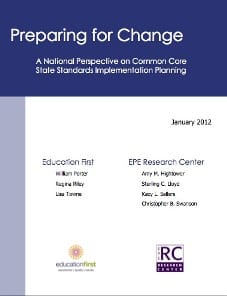 Last
week, a report was released by Education First and the EPE Research
Center entitled Preparing
for Change. The report is the first in a series of three that will look
at whether states have developed Common Core implementation plans that address
three areas of CCSS implementation:
Last
week, a report was released by Education First and the EPE Research
Center entitled Preparing
for Change. The report is the first in a series of three that will look
at whether states have developed Common Core implementation plans that address
three areas of CCSS implementation:
- Developing a plan for teacher professional development,
- planning to align/revamp state-created curricular and instructional materials, and
- making changes to teacher evaluation systems.
Many
CCSS supporters cheered at the report’s main finding, which indicated that all
but one state—Wyoming—“reported
having developed some type of formal implementation plan for transitioning to
the new, common standards.” There is cause for excitement—this is a clear
indication that states are taking CCSS implementation seriously and that they
are working to reorient their education systems to the new standards.
That said, while developing implementation plans is an important first step, it’s far more critical to ensure that those plans are worth following—that they properly identify the gaps in teacher knowledge and skill so that they can target state-led PD efforts, for example, and that they prioritize the essential components of the CCSS in state-created curricular and instructional materials. This report doesn’t get into these questions of quality—though Education First and EPE will release two follow-up reports in the coming months that address the quality of the state plans. The first will include a rubric against which state plans will be judged, and the second will be a report of state progress against the benchmarks outlined in the rubric.
As I wrote a few weeks ago, there is reason to be nervous that states may be spending a tremendous amount of time and energy developing and implementing plans that might not address the essential curricular and instructional changes the CCSS demand.
Let’s hope that the follow-up reports—in particular the rubric that will be used to judge the quality of statewide CCSS implementation plans—look critically at where standards implementation has fallen short in the past and help identify what we need to do to correct those mistakes. This is our chance not just to raise the expectations for all students, but also to rethink the way to approach state standards implementation. Let’s seize the opportunity and make sure we’re getting it right.
